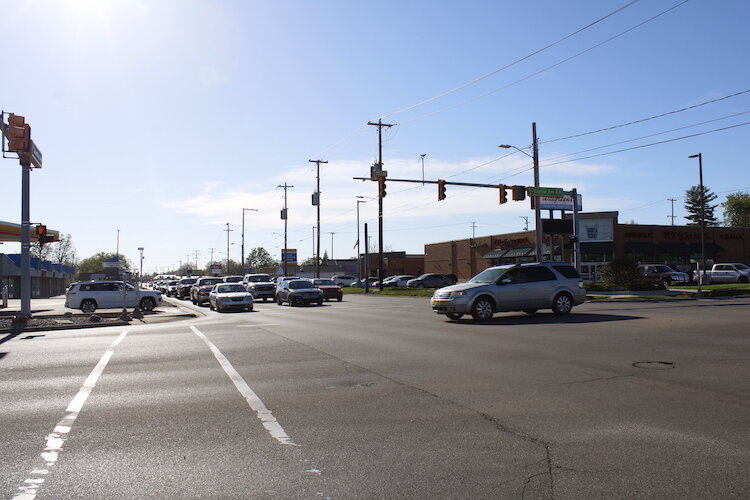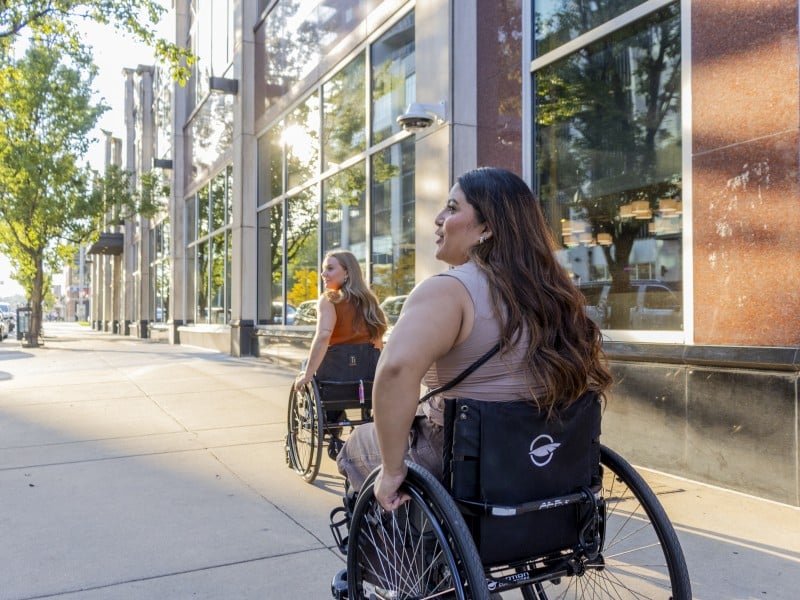Voices of Youth: Self-driving vehicles are coming to Calhoun County — ready or not
While the technology is still developing, it's only a matter of time before driverless cars come to Battle Creek — and to other cities across the state. Three larger cities already have robotaxies. What are some advantages to self-driving vehicles and how do we prepare?
Editor’s Note: This story is part of Southwest Michigan Second Wave’s Voices of Youth Battle Creek program which is supported by the BINDA Foundation, City of Battle Creek, Battle Creek Community Foundation, and the Michigan After School Partnership. This series features stories created by Calhoun County youth in partnership with professional mentors, as well as feature stories by adult writers that examine issues of importance to local youth.
BATTLE CREEK, MI — Self-driving vehicles are coming to Calhoun County, perhaps sooner than you think. Are we prepared for them? Multiple jurisdictions in Michigan already allow limited use of autonomous cars, but few are ready for widespread adoption.
Many people think self-driving cars will never exist — or are many years away from being on the road and available to the general public. But that may not be the case.
As technology advances, we are seeing companies like Waymo, Cruise, and Tesla retrofitting existing or new vehicles with hardware that allows vehicles to operate with little to no driver intervention. The technology that surveys and processes the information around the vehicles (allows the vehicle to “see”) varies widely. Waymo, for example, is using a mixture of Lidar, Radar, and cameras. Tesla vehicles rely on pure camera vision for its self-driving hardware, removing the previously included radar and ultrasonic sensors from its vehicles as a cost-cutting measure.
There are varying levels of autonomy for cars. According to the Environmental Protection Agency website, “The Society of Automotive Engineers (SAE) has defined five levels of automation, from Level 0 to Level 5, with Level 5 being full automation. The most advanced vehicles available today are already functioning at a Level 2, and many manufacturers are promising higher levels of automation in the near future.”

Although self-driving vehicles are already in operation, many people are unaware of their existence. For example, Waymo and Cruise are examples of Level 4 autonomy. Still, they are restricted to certain areas of major cities and/or during certain operating hours. Tesla’s Full-Self Driving (FSD) capability is only a Level 2 autonomous platform, but it is capable of driving itself anywhere with minimal driving intervention.
Many people may be afraid of being driven around in a vehicle operated by a computer. Currently, no legislation in the United States allows any car to be fully autonomous and operable without a person in the passenger seat. Concerns arise when issues occur regarding these vehicles’ safety.
Opinions varied heavily when surveying new and experienced drivers on self-driving cars in the Battle Creek area. Nicholas Wawzysko, a Lakeview High School student, says, “I think that with autonomous driving being a very young addition to vehicles, I find it somewhat difficult to fully believe it’s safer than driving myself, as I have been in a Tesla with FSD activated and there [were] some very concerning issues with road mapping. However, the one thing I have never seen a car company do before is send data from every Tesla to a database to improve its performance on the road further… and that is just impressive.”

Federico Conde, a Lakeview High School parent (full disclosure: my own) with more than 35 years of experience in driving, says, “I certainly wish we had fully autonomous vehicles. I have to travel often for work, which requires me to be on the phone and join remotely, and the ability for the car to drive itself would take a lot of stress off of me.”
Yet challenges to the engineering persist. Cruise, the self-driving car company owned by General Motors, recalled 950 of its driverless cars after colliding with a pedestrian in November. Similarly, Waymo recalled a portion of its autonomous car fleet after a collision with a pickup truck that was being “improperly towed.” Waymo previously also had an incident where another one of its vehicles struck a cyclist.
The technology of the existing semi-autonomous vehicles is certainly not flawless, but it is improving rapidly. The computer running the self-driving hardware on Waymo, Cruise, and Tesla can be updated wirelessly through software updates, allowing companies to fix any issues they’ve experienced and continuously improve the customer experience.
Tesla’s approach to autonomous vehicles is different. Tesla is not certified for Level 4. Autopilot and Full Self-Driving (Supervised) (FSD) must always have a driver behind the wheel paying attention. The difference between FSD and the rest of the companies is that although it has a Level 2 certification and operates with just seven cameras instead of an expensive suite of sensors, it can be used anywhere, unlike Waymo or Cruise. Being a Level 2 system means the driver is liable for any damages caused while using FSD, not Tesla.
Like most cities, Battle Creek experiences more traffic accidents at intersections with high vehicle volumes. According to Darren Campbell, the City’s Traffic Engineering Manager, prime examples include Capital Avenue, Helmer Road, and Riverside Drive, and where these streets intersect at Columbia Avenue and Beckley Road.
“The two most common types of mishaps at these intersections are angle and rear-end crashes,” says Campbell. “The angle crashes occur for a multitude of reasons, but if I had to say there was one situation I see more than others, it’s when one last person tries to make the left turn against a red light and runs into someone coming through on a green light.”
As research continues, the safety benefits of the existing technology are starting to show. Tesla publishes its vehicle safety report yearly, which shows the miles driven per accident with the average in the United States and for Tesla vehicles using Autopilot technology. According to Tesla, FSD has driven more than one billion miles. Similarly, Waymo goes in-depth on its safety regarding autonomous vehicles and has reported an 85% reduction in injury-causing crash rates with more than 7 million miles driven.

City engineers are keeping an eye on advancements. “As a local municipality, our best course of action will be to follow state and federal guidelines as they evolve,” says Battle Creek’s Campbell.
Autonomous vehicles also benefit the consumer. With a self-driving car, you would be your car’s passenger. Driving, especially in congested cities, can be extremely stressful. In an autonomous vehicle, the passenger could work freely, read, or even sleep while waiting to arrive at their destination. This would help mitigate anxiety and allow you to focus on other things while commuting.
In an article written by the American Automobile Association (AAA), Americans Spend an Average of 17,600 Minutes Driving Each Year, Jurek Grabowski, the research director for AAA, says, “The amount of time the average driver spends behind the wheel each year is equivalent to seven 40-hour weeks at the office.”
Businesses could also see an advantage in using autonomous vehicles. Public transportation like taxis or buses would decrease in price due to the lack of a driver. Another benefit would be that there would be no shortage of drivers, meaning that requesting a ride at any time of the night would be possible even when living in a big city.
Benefits would extend to food, groceries, and medicine deliveries. All of these items could be delivered quicker, at a lower cost, which in some cases, like with medicine, could be lifesaving. As of April 3, 2024, Uber has partnered with Waymo to offer rides natively within the Uber app and food delivery. While the greater Battle Creek area has yet to participate, and the availability is still limited to select cities and merchants, the foundation for this technology has already been put in place.
While autonomous vehicles currently have their limitations, such as the potential for accidents and imperfect decision-making, they possess the capability to improve over time. By integrating them into real-world conditions and collecting data, the software and hardware of these vehicles can be refined, resulting in better performance and enhanced safety. It is crucial to acknowledge that achieving a flawless self-driving system requires real-world testing and continuous refinement based on collected data.
The idea of self-driving cars appears highly promising, with the potential to become an important part of our future. However, it is crucial to acknowledge both the benefits and the limitations of such vehicles. Despite their perceived near-perfection, they are not without flaws and will require extensive validation and testing. While public opinions on self-driving cars may vary, as time progresses, exposure to these vehicles will increase, leading to a more informed understanding among the general populace.
According to Campbell, traffic engineers use a publication issued by the Federal Highway Administration (FHWA) called the Manual of Uniform Traffic Control Devices (MUTCD) to help guide local traffic engineering decisions. The publication was recently updated in January 2024 and included a new section dedicated to automated vehicles.
“Although the section offers no standards at this point (on autonomous vehicles) and occasionally offers general guidance to policy and principles… it definitely has a feel of a foundation being set,” says Campbell. “This will likely be updated as more advances are made with autonomous vehicle technology.”

Rodrigo Conde is a senior at Lakeview High School. Rodrigo has had a passion for technology at a very young age and intends to pursue a career in computer engineering and science.














